Fig insect pests
Stem borer
Biology:
- Egg: The female cuts the tree bark and lays eggs singly into these cuts, laying a total of up to 200 eggs. Egg is a brownish-white cylinder, 6.2 mm, with narrowly rounded ends. On hatching the larvae start to tunnel into the sapwood of the trunk or branches.
- Larva: Larval development takes about 2 years. As a very large species, the larval tunnel measuring 2 or 3 centimeters in width that is correspondingly large and very damaging to the tree. The larvae tunnel through the sapwood and because of their size, they make large tunnel which interfere with sap flow and affect foliage and fruit production.
- Adult: The adult beetle emerges by a short tunnel running to the exterior and ending in a circular exit-hole. The maximum life recorded for the adult is eight months.
Life cycle:
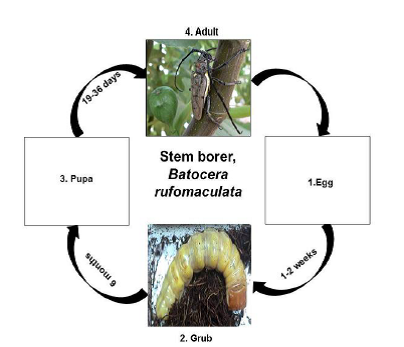
Damage symptoms:
- Grub tunnels in the sapwood on the trunk or branches
- Grub bore into the sap wood and making irregular tunnels.
- Feeding the vascular tissues
- interruption of nutrient and water transport on the tissue
- Drying of terminal shoot in early stage
- Frass comes out from several points and sometimes sap oozes out of the holes
Fruit flies
Biology: Development from egg to adult under summer conditions requires about 16 days. The mature larva emerges from the fruit, drops to the ground, and forms a tan to dark brown puparium. Pupation occurs in the soil. About nine days are required for attainment of sexual maturity after the adult fly emerges. The developmental periods may be extended considerably by cool weather. Under optimum conditions, a female can lay more than 3,000 eggs during her lifetime, but under orchard conditions from 1,200 to 1,500 eggs per female is considered to be the usual production. Apparently, ripe fruit are preferred for oviposition, but immature ones may also be attacked.
- Egg: The white, elongate and elliptical egg measures about 1.17 x 0.21 mm and has a chorion without sculpturing
- Larva: The third-instar, which has a typical maggot appearance, is about 10 mm in length and creamy white. The only band of spinules encircling the body is found on the first segment. The external part of the anterior respiratory organs, the spiracles, located one on each side of the pointed or head end of the larva, has an exaggerated and deflexed lobe at each side and bears many small tubercles. The caudal segment is very smooth. The posterior spiracles are located in the dorsal third of the segment as viewed from the rear of the larva.
- Pupa: The mature larva emerges from the fruit, drops to the ground, and forms a tan to dark brown puparium about 4.9 mm in length. ‘
- Adult: The adult, which is noticeably larger than a house fly, has a body length of about 8.0 mm; the wing is about 7.3 mm in length and is mostly hyaline. The color of the fly is very variable, but there are prominant yellow and dark brown to black markings on the thorax. Generally, the abdomen has two horizontal black stripes and a longitudinal median stripe extending from the base of the third segment to the apex of the abdomen. These markings may form a T-shaped pattern, but the pattern varies considerably. The ovipositor is very slender and sharply pointed.
Life cycle:
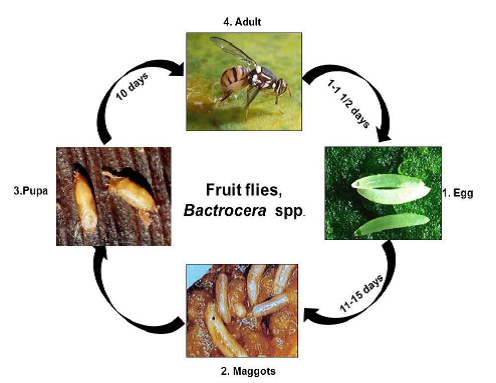
Damage symptoms:
- The damage to trees caused by fruit flies result from 1) oviposition in fruit and soft tissues of vegetative parts of certain plants, 2) feeding by the larvae, and 3) decomposition of plant tissue by invading secondary microorganisms.
- Larval feeding in fruits is the most damaging. Damage usually consists of breakdown of tissues and internal rotting associated with maggot infestation, but this varies with the type of fruit attacked. Infested young fruit becomes distorted, callused and usually drop; mature attacked fruits develop a water soaked appearance. The larval tunnels provide entry points for bacteria and fungi that cause the fruit to rot. When only a few larvae develop, damage consists of an unsightly appearance and reduced marketability because of the egg laying punctures or tissue break down due to the decay.
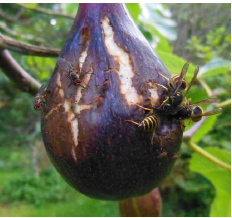
Natural enemies of fruit flies:
Predators: Rove beetles, weaver ants, spiders and birds and bats
Parasitoids: Opius longicaudatus, O.vandenboschi, O.oophilus and Bracon spp
Mealybug
Biology:
- Eggs: The life cycle of D. stebbingi starts with egg laying in loose soil around infected trees. Between April and May, purple-colored eggs are laid in egg-sacs comprising mass of wax threads, in the loose soil around (within 2–3 m radius) the infested mango trees.
- Nymphs: The nymphs emerge with the rise in temperature during January and travel up the trees via stem to feed on cell sap, adjacent to the fruiting parts. Therefore, heavy immature fruit falling occurs. Eggs hatch in December–January and nymphs start ascending the trees to succulent shoots and base of fruiting parts.
- Adults: the flying males emerge to mate with the flightless mature females while crawling down to the ground for egg laying. Female and male appearance starts during March–April. Males are winged and short-lived after mating, and do not cause damage to the trees. Drosicha stebbingie has a total lifecycle of 24-26 days.
Life cycle:
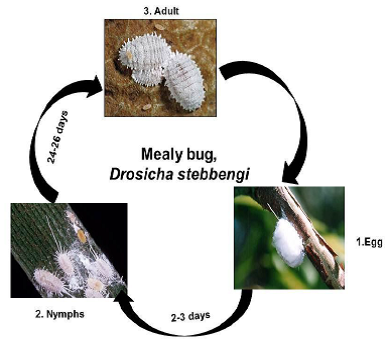
Damage symptoms:
- Occurring primarily in older, well-shaded groves planted on heavy soils.
- They will feed on the roots, bark, foliage, and fruit. The mealybug injects toxic salvia while extracting plant sap resulting in defoliation, fruit discoloration, fruit splitting, and fruit drop.
- Mealy bugs usually gather in large numbers, causing premature leaf drop and twig dieback when they feed. Like psyllids, they secrete honeydew, which attracts black sooty mold
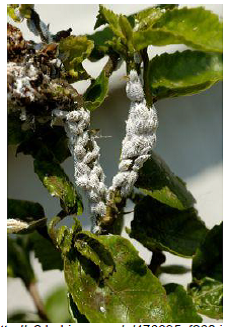
Natural enemies of mealybug:
R. fumida, Chrysoperla zastrowii silemi and Cacoxenus perspicax
Coccid
Biology:
Adults: Adults are flat and oval, approximately 3mm in length, pale yellow and covered with wax. One female can lay an average of 200-300 eggs per cluster.
Life cycle:
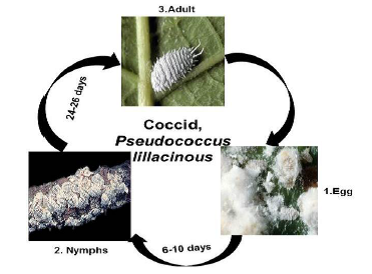
Natural enemies of coccid:
Coccinellids, P. kenyae, Chilocorus sp., Hyperaspis, Scymnus, Cryptolaemus
Leaf roller
Biology:
- Eggs: They laid 3-81 eggs singly or in batches on either side of the leaves. Eggs hatched in 4.74-5.94 days
- Larva: Larvae fed on the mesophyll gregariously (1st instar) or individually (later instars) under the silken webs spun by them. Larvae were full-grown in 30.60-35.87 days
- Pupa: the pupal stage among the plant debris under the trees
- Adult: This insect remained active from March to Sept. and passed through 4 overlapping broods. Moths lived for 3.6-10.57 days.
Life cycle
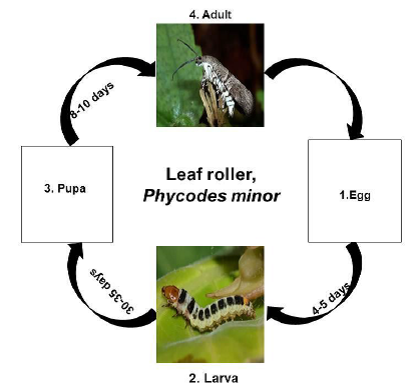
Damage symptoms:
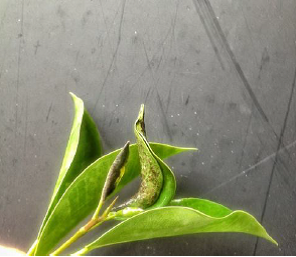
Natural enemies of leaf roller:
- Parasites: Apanteles angeleti, Trathala flavo-orbitalis and Cadurcia vanderwulpi
- Predators: lacewings, assassin bugs, and minute pirate bugs.
Fig moth
Biology:
- Eggs: The eggs are translucent yellow with a sculptured surface.
- Larva: The larvae range from 1.5-15 mm in length and are light brown with dark brown spots with a sparse covering of hair.
- Pupa: Pupae are dark-brown and found within a relatively light pupal case.
- Adult: The adult forewings are greyish-brown with scattered darker patches. The wing span is 11-20 mm and both fore- and hind-wings have broadly rounded tips and short fringes of hairs.
Life cycle:
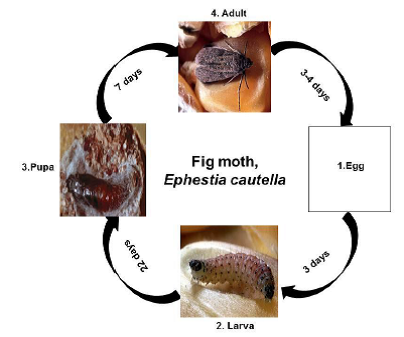
Natural enemies of fig moth:
Parasitoid: Habrobracon hebetor, Antrocephalus mitys
Thrips
Biology:
- Egg: The eggs are microscopic (0.075 mm long and 0.070 mm wide), kidney-shaped and creamy white in color. The eggs hatch between two to seven days, depending upon temperature. Larvae and adults tend to gather near the mid-vein or borders of the host leaf.
- Larva: The two larval stages are completed in eight to ten days and the pupal stage lasts for 2.6- 3.3 days.
- Pupa: pupae are generally found on leaves, leaf litter or on the axils of leaves, in curled leaves or under the calyces of flowers and fruits.
Life cycle

Natural enemies of thrips:
Predators: minute pirate bugs, Orius spp.
Scale
- Egg: Eggs are laid under the female scale and are 0.2.0.3 mm long. Initially pale orange, they turn pink before hatching. Red eyespots are visible within the eggs before they hatch.
- Crawlers: They are are light pink.orange with red or black eyes, 0.2.0.3 mm long. They are most abundant in summer (December). There is a second smaller generation in autumn (March-April). Crawlers can be dispersed by wind and workers, or on farm machinery. Although crawlers can wander for up to 36 hours, they usually settle within 2.3 hours. Once settled, (usually on the midrib of a leaf) crawlers shed their skin (moult). First instars are 0.6.0.8 mm long and 0.2.0.4 mm wide.
- Adult The ridges of the letter 'H' are distinct and are characteristic of black scale. When egg laying commences, the scale surface becomes smoother and darker, almost black. The female dies 38 after laying eggs, though the scale covering remains on the leaves or twigs. The size of adults is variable, 1.9-5 mm long, 1-4 mm wide and 1.2-2.5 mm high.
Life cycle
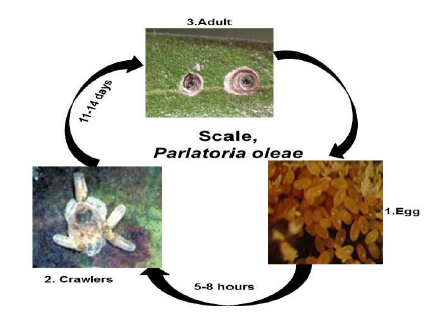
Damage symptoms:
- The direct damage is caused by insertion of stylets during feeding by the nymphs, which can cause premature leaf drop and twig dieback.
- High populations can cause host death. Severe infestations may result in shoot or branch dieback
- When large populations of scale occur, sooty mold may become a problem due to the mold’s growth on the large quantities of honeydew excreted by these scales
Natural enemies of Scale:
- Parasites: Aphytis maculicornis and Coccophagoides utilis.
- Parasitoids: Encarsia perniciosi and Aphytis diaspidis
- Predators: Chilocorus infernalis, Chilocorus rubidus, Pharoscymnus flexibilis
IPM for Fig
To know the IPM practices for Fig, click here.
Source: NIPHM; Directorate of Plant Protection, Quarantine & Storage
Last Modified : 3/30/2020
This topic covers information about Pomegranate I...
This topic covers information about Description of...
This topic provides information about Cherry- Inse...
This topic covers information about Description of...
